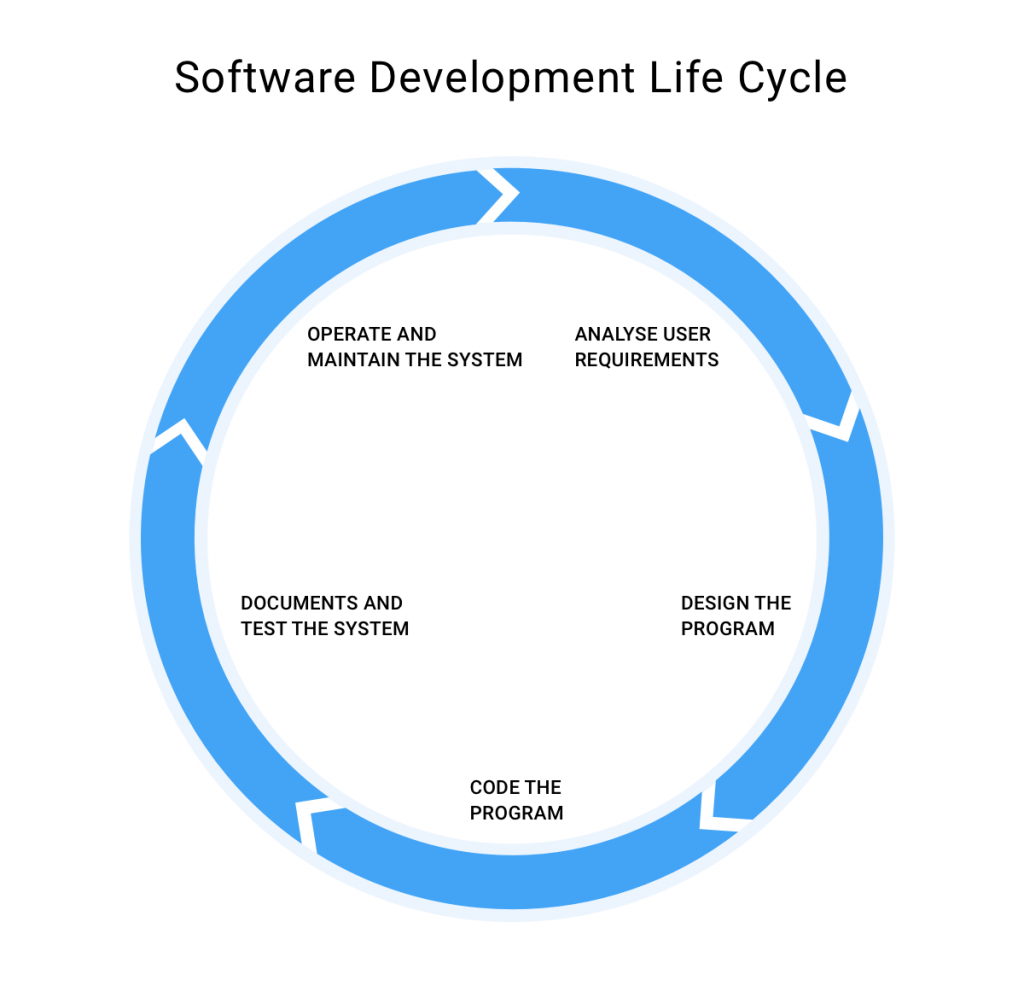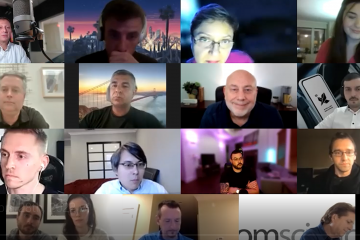Understanding SDLC Is Important For Startups
The term SDLC is an abbreviation for the Software Development Life Cycle.
Let’s clear up one thing from the start – all businesses, knowingly or unknowingly, have become reliant on technology.
Here’s a practical scenario to help understand this concept.
Imagine owning a clothing business that doesn’t solely operate in the digital realm. Your company, despite its non-digital merchandise, will have a hard time competing with a competitor that implements automation, uses cutting-edge tracking tools, employs an effective digital marketing policy, and offers near-instant inventory updates. We haven’t even approached the aspect of design, have we? So why is this? Simply because being distinct isn’t sufficient for survival in the current business environment.
Some may reject the notion that their business falls under the umbrella of technology. Despite this denial, this standpoint is usually ill-conceived. Modern business technologies have become so ingrained in our everyday lives that we often neglect their existence. This unnoticeability indicates that a technology has transitioned from its adoption phase to becoming conventional. Within this perspective, acknowledging technology’s impact on our business concepts becomes crucial.
Explaining the Software Development Life Cycle
Like any complex project, the journey of software development requires key phases like detailed planning, careful preparation, feasibility assessments, dividing convoluted tasks into manageable chunks, and assigning tasks to teams or individuals.
SDLC serves as a fundamental guideline for defining tasks and steering the project’s pathway.
Fundamentally, the SDLC is a well-ordered skeleton: a tactic aimed at governing and managing the development of software. Its goal is to maintain client-centric support throughout the software implementation process, making sure that the client’s initial expectations are fulfilled. Additionally, it incorporates various tests to corroborate the feasibility of the primary concept.
Contrary to popular belief, the SDLC doesn’t embody a management methodology. Rather, it offers a well-structured framework comprising distinct software development stages for development squads.
These stages of software development include duties like analyzing user demands, software design, implementation, creating documentation, testing the executed software, and ultimately, managing software operations and maintenance.
Adhering to the aforementioned steps can pave the way for a streamlined, efficient, and productive software development process, resulting in superior outcomes that fulfill user requirements.

Here, the portrayed workflow diagram outlines five distinct phases. To foster a clear comprehension of responsibilities and their importance, it is vital that these stages of the Software Development Life Cycle (SDLC) are well defined and thoroughly communicated to each participant involved in the software project.
Unraveling the SDLC Stages
Let us dissect and thoroughly explain each stage involved in the Software Development Life Cycle (SDLC) for an in-depth understanding of this software project.
Requirements and analysis
The initial step in these series of procedures is the phase in SDLC where we gather the client’s requirements, study the feasibility of the idea, plot the route of future functionality, juxtapose it with existing products, and scout for innovative ways to honor the original concept.
When the product you’re crafting springs from your mind, you’re essentially the end user. It’s frequently the inventor stepping up to undertake the task of documenting everything. This endeavor can be intimidating as it entails contemplating all potential necessities, intricate details, crafting branches, and ultimately formalizing business regulations. Ideally, this should also include mock-ups to guide the creativity of the developers in alignment with your initial product vision.
At the end of this SDLC phase, a requirements document or a product description document, for the more visionary, should emerge.
Here are a few strategies that may be deployed to collate requirements and undertake analysis:
- Customer Interviews (one-on-one or group)
- Facilitated Sessions
- Joint Application Development
- Prototyping
- Collection and Review of Proposals
- Brainstorming Sessions
Design
Before initiating a software development process, the presence of top-tier tech specialists is indispensable. Their expertise is vital in transforming your needs into a refined form apt for delivery to your software development department.
The initial phase entails making significant technological stack decisions, establishing input and output processes, designing data and form structures, among others.
This phase usually culminates into a compilation of documents and flow diagrams that portray your business functions, user experience with your software, data format and storage requirements, etc. The creation of wire-frames typically proves beneficial as it facilitates a meticulous probing of details while exposing potential voids in your idea, business methods or paperwork.
Implementation
During the software implementation phase, your envisioned software begins to materialize as specs and requirements are converted into tangible coding.
In this phase, engagement with your software developers amplifies, and your emphasis should be on ensuring that requirements are suitable and developers adhere strictly to guidelines.
During the real development phase, it’s normal for adjustments in requirements to occur. This doesn’t necessarily signify a glitch in the early stages. It rather highlights the intrinsic dynamics of creating intricate systems – as you commence building, you obtain more profound comprehension of the obstacles, which necessitates strategic decisions and modifications of approach.
It’s imperative to highlight the significance of thorough supervision and component review throughout the software development to ascertain compatibility among different elements. Current software development ethos advocates creating small components, which widens the spectrum for easier alterations and scalability. However, this technique raises the complexity of maintenance and necessitates rigid interface protocols to ensure the development of a unified product.
Testing
Appraisal procedures inherent to the Software Development Life Cycle (SDLC) play a crucial role in generating a superior product. This involves the dedicated deployment of resources to assess and validate the work done by the software development team. It is imperative to diligently detect and correct logic anomalies, workflow discrepancies, design faults, and usability issues, upholding high standards before transitioning to a public launch.
At this point, it would be prudent to revisit the documents and outcomes from the requirement gathering stage. These documents serve as vital resources for your Quality Assurance engineers, offering a framework to create comprehensive test cases. The documents initially curated now function as verification checkpoints and application scenarios for the Quality Assurance team, ensuring the software undergoes a thorough examination and approval process before reaching the end users.
Quality Assurance is a cyclic process. With the identification of issues, the QA engineers progressively refine the software until they are satisfied with its standard. The product must also align with the requirements specified at the outset.
Encouraging stakeholders to engage during this stage promotes acceptance testing. In this phase, the stakeholders endorse and eventually provide their formal acknowledgment or ‘sign-off’ to the proposed solutions, setting the stage for the final steps.
Deploy and Maintenance
While this phase may mark the termination of your current workflow, it also signifies the onset of new adaptation procedures.
The latter part of the SDLC pertains to the final ‘nudge’ to propel the product from the manufacturing stage to functional usage.
Deployment signifies the movement of thoroughly examined and validated code from your internal servers to your production-grade servers, making the software available to the public. Once this transition is smoothly accomplished, the undertaking of application surveillance and upkeep begins.
Regardless of the nature of the application, proactive monitoring is critical, incorporating user queries, performance difficulties, environmental effects, and more. This step necessitates distinct proficiencies potentially needing the expertise of an individual with significant DevOps experience within your team.
Understanding SDLC Requires Much More Than Following These Five Phases
Understanding the complexities of the Software Development Life Cycle (SDLC) is imperative. Yet, it is important to remember that it does not provide a complete picture of the software construction process. While the SDLC undoubtedly presents a valuable methodology, it stands too generalised to deal with the fine details of actual development work.
Surely, the importance of requirement gathering cannot be overlooked. However, the actual scenario might be more complex than what the SDLC framework might have made you imagine.
Modern-day software development predominantly adopts the Agile methodology. It is essential, however, not to view Agile merely as a means of managing projects. Categorizing it just as a “project management” approach may indeed be insufficient.
At its core, the SDLC equips one with a broad-level perspective of what an ideal software development process should resemble. Yet, as you delve deeper into a specific project, you’ll notice that the process isn’t as neatly streamlined as portrayed by the SDLC.
An apt comparison would be a sequence of small-scale SDLC operations performed repetitively. Starting with the accumulation of requirements that are occasionally not well-defined, mainly due to unfamiliarity with the problem or a requirement for a usability test. Developers then interpret these somewhat unclear instructions into actual software applications, which are then tested before being presented before the client. Client feedback might lead to revisions in the documentation process prior to the next round of coding, inclusive of further testing.
The proposed solution, once meeting customer satisfaction criteria and receiving quality approval from the QA team, progresses to production deployment.
It is important to note that the frequency of this deployment can significantly vary, ranging from monthly to hourly schedules, particularly for larger and more experienced teams.
Conclusion
The Software Development Life Cycle is a critical blueprint that outlines the top-level understanding of processes involved in the creation and delivery of software applications.
Aligning your project’s tools and techniques with the SDLC is vital to promoting optimal productivity. With numerous and varied project management methodologies available, it falls under your responsibility as a business owner to choose the one that aligns best with your company culture, addresses your team’s requirements, and accommodates your project’s scale.
Leverage the SDLC process during tool selection, team needs analysis and scope specification. The application of this methodology equips you with the necessary tools for cost-effective development and timely delivery of quality software.



0 Comments